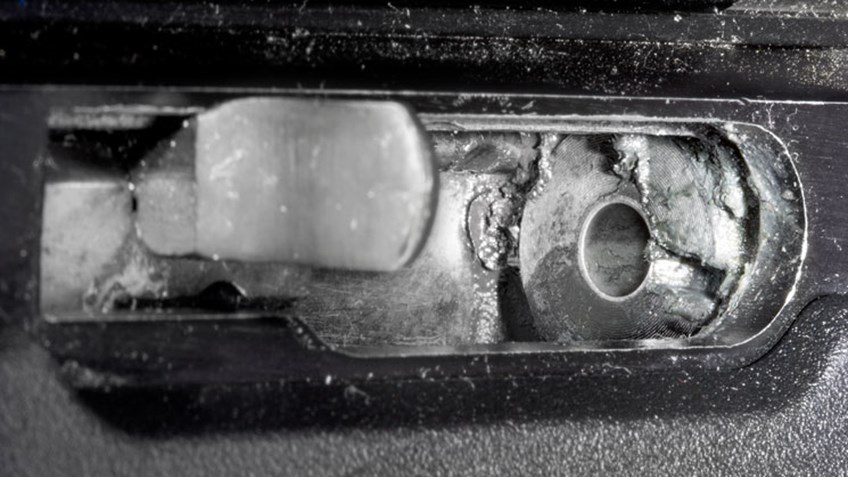Contrary to what some will tell you, YES, a .22 rimfire needs to be thoroughly maintained to perform its best. Here’s why…
by George Harris, NRA Publications
“My Ruger 10/22 with a bull barrel has been one of the most accurate .22 LR rifles I own — until recently. It feeds and functions perfectly, but all of a sudden it started throwing random shots and I am at a loss as to why. I have noticed some of the spent brass with a slight bulge at the rim, but I can’t correlate those with the bad shots. One of my friends suggested the ammunition might be at fault, but it does the same thing with several different brands and types of fodder. I was told when I bought the gun that it never needed cleaning (just a little lubrication now and again) but I am thinking of at least swabbing the barrel to see if it would help the accuracy problem. Am I overlooking something? What would you suggest as far as cleaning and getting my rifle shooting like it used to?”
— Peter Hoyle
Raleigh, NC
Contrary to what some believe, all .22 LR firearms need more maintenance than occasional lubrication. Bulged cases are significant indicators that the chamber and/or the throat have enough firing-residue buildup to prevent a cartridge from fully seating, which causes the rifle to fire slightly out of battery. Residue on the bolt — even with lubrication present — tends to degrade the ability of the mainspring to close the action because the cartridge is restricted as it is seated in the chamber. Furthermore, buildup on the face of the bolt and barrel where they meet contributes to this problem. Accuracy can also be affected by these conditions because the position of the cartridge in the chamber is not consistent.
Rimfire ammunition is somewhat unique in that it has four contributing factors to barrel fouling. The wax used to lubricate the bullets is the most obvious. Different manufacturers use various formulas and amounts of lubricant, all of which contribute to buildup inside the barrel and in the action.
Almost all .22 LR bullets are lead, even those copper-washed. All leave material in the barrel, which degrades accuracy over time. If one were to look through the barrel of any .22 LR after firing a few shots, there would be particles of burned and unburned powder left, which are just as likely to be forced into the grooves of the barrel as to be pushed out of the muzzle when the next shot is fired. Carbon buildup in any barrel is one of the worst detractors to acceptable accuracy.
Often overlooked is the priming compound used in rimfire cartridges. Not only does it have an abrasive component in it, but it is some of the most difficult fouling to remove from a rimfire barrel as a result of its pressure and heat.
It is thought the residuals from the primer, powder, and projectile-lubricant amalgamate at the cartridge seat where the chamber ends and the throat begins, causing a hard, restricting ring of material the bullet has to pass through when fired. In my experience with my match guns, I have had to carefully use a chamber reamer to remove this buildup where the bullet enters the barrel’s throat.
Thoroughly clean the rifle inside and out. This will reduce the variables that degrade function and accuracy. Disassemble the rifle per the owner’s manual, remove all of the firing residue and other foreign material. Lubricate all of the moving parts with a quality gun oil.
The barrel should receive special attention to remove all of the fouling down to the base metal. Start with soaking the bore with a name-brand solvent designed to remove carbon and lead. After brushing with a bore-fitting nylon or bronze brush, push a few clean patches through to remove the fouling. If there is evidence of fouling still present, Kroil or other brands of penetrating oil work well for loosening hardened buildup collected over time. In extreme cases, an abrasive such as J-B Non-embedding Bore Compound may have to be used.
Once the barrel is clean and the rifle assembled and lubricated, select several brands of match ammunition of which you have a good supply. You will have to “season” the barrel with five to 10 shots on average to bring it to optimum accuracy. Shoot some groups and record the results. Then, clean the barrel back to base material again and repeat with the next brand of ammo. In your record-keeping, you will see the rifle’s performance start to fall off in the accuracy department typically around 100 to 150 rounds. Each rifle has its own personality, so it could be more or less. Once accuracy starts dwindling, clean the barrel again as previously mentioned to bring it back to its optimum capabilities.
Check out cleaning supplies at Midsouth HERE









